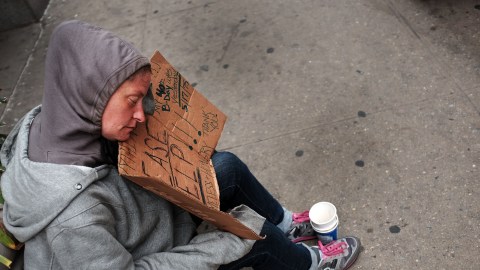Three in Five Americans Have Experienced a Year of Poverty

How likely is it that someone will experience poverty within their lifetime? Three in five, according to a new study published in Plos One.
Researchers Mark R. Rank and Thomas A. Hirschl did a long-term study, analyzing data from the Panel Study of Income Dynamics, which followed 4,800 households from 1968 to 2011. They followed groups of people from ages 25 to 60 in order to get a sense of how many people will fall into poverty and extreme poverty within their lifetimes.
The researchers write:
“Our focus is upon the extent that individuals experience relative poverty over time, the life course timing of poverty, whether this experience is long-term or acute, and the characteristics of those who are more likely to experience relative poverty.”
The researchers do battle with the definition of poverty, wanting to seek an accurate measurement of income and conditions. For example, someone’s income may be below the poverty line, but they could be getting help from relatives or they could be living out on the streets. However, their data restricts them to using only income as a marker.
The results are quite interesting and describe the fairly porous nature of poverty in America. They write:
“Our results indicate that the occurrence of relative poverty is fairly widespread. Between the ages of 25 and 60, 61.8 percent of the population will experience at least one year of poverty, whereas 42.1 percent will experience extreme poverty. Furthermore, 24.9 percent of the population will encounter five or more years of poverty, and 11.4 percent will experience five or more years of extreme poverty.”
There are certain variables that increase this risk. For instance, if a person is younger, with less than 12 years of education, has a work disability, isn’t married and white, and is female, these characteristics increase the odds that a person will encounter a year of poverty.
Based on this study, I would be one of the people who has “encountered poverty.” After quitting work to become a freelancer, it took me a year to gain enough work to raise my income past that line. But I did not live in poverty. Before I made the change in careers, I worked a salary job and saved up before I made the switch.
My story of dipping below the poverty line isn’t everyone’s; I don’t want to make light of the income inequality concerns this nation is facing. What this study reveals, though, is that the class structure is not as rigid as we might be led to believe. Instead, they write that this finding “provides an interesting and important caveat to the overall story of rising levels of income inequality across the past 40 years.”
The income issue is a complex one; the results of Vermont raising the minimum wage last year did not provide the solution for many workers. But some believe a basic income structure may help cure wage woes.
The president of Iceland says the secret to the Nordic countries’ recent economic and social success is all thanks to social welfare programs, such as free access to education and health care, which have proved to be a boon to the free-market economy.
Read more about the study at Plos One.
Photo Credit: Spencer Platt / Getty Staff





